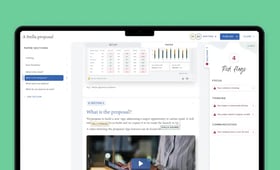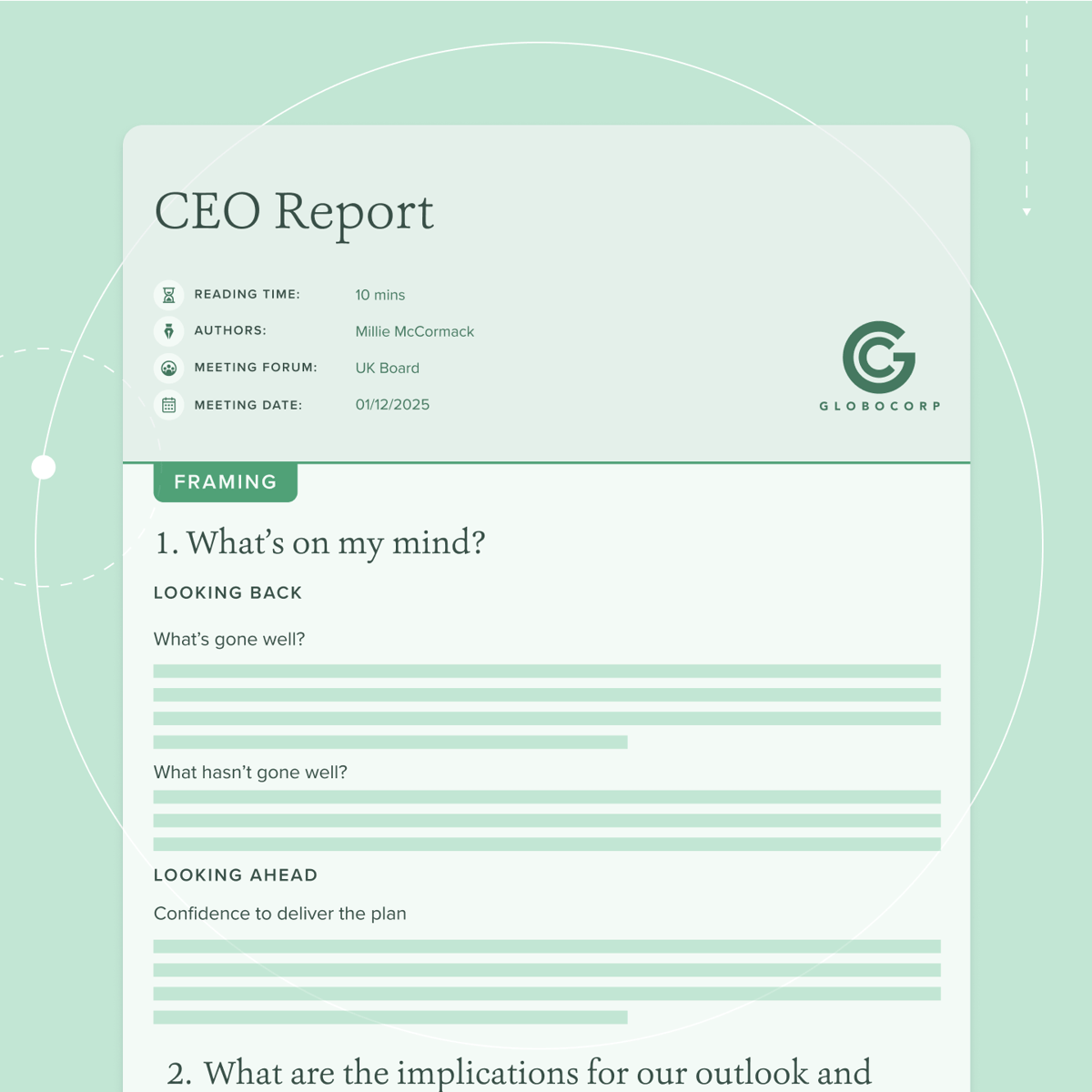Directors tell us that the CEO’s report is the most important paper in their board pack — and the one they turn to first. But, despite its importance, few organisations get it right.
The pitfalls are plentiful. Time-poor CEOs might assume board members will find everything they need in their team’s papers. Or that directors will be frustrated at having to read a paper that duplicates content they can find elsewhere in their 200+ page board pack. So, why bother with a written report, when a verbal one — or a few bullet points — will do?
The fact is, it won’t do. The CEO’s report, done well, not only affords chief executives an invaluable opportunity to reflect and tap into the expertise of their board members, it also answers the question, “What’s on my mind?” And knowing what’s on the CEO’s mind is key for an effective board.
What’s the CEO’s board report for?
A CEO’s report isn’t an assignment given by the board to the chief executive, with the latter trying to please — or appease — the former. Rather, it’s something that should have value for both.
For the board
For the board, and especially the non-executives, the CEO’s report is the go-to place where they can get the lay of the land and find out where their support is needed. New developments that may seem obvious to an executive team living and breathing the business may not always be self-evident for directors, and the CEO’s report helps fill that gap.
The best CEO’s reports help you navigate the actual board pack. Once you’ve read these, you know the four or five places in the rest of the pack that you’ll need to read thoroughly and bring your A-game to.”
Penny Hughes CBE, Chair, The Gym Group, Riverstone
With packs growing longer every year, and with papers too often coming late to the board, the CEO’s report is also an invaluable signpost. Research that we jointly conducted with Cambridge Judge Business School found that the average time a board member spends reading a board pack is just shy of four hours and that, in most cases, almost half the content is going unread.
By confirming what’s going as planned and highlighting what the organisation needs help with, the CEO’s report lets directors know what they should focus on first and ensures it doesn’t get buried under the sheer volume of the pack.
For the CEO
Without a steer, non-executives often focus on the second part of their role: supervision. For the chief executive, the CEO’s report is an opportunity to provide that steer and shape or rebalance the board’s conversation towards its other role: guidance. It’s where a CEO can make a direct ask and focus the directors’ attention on the big questions — ensuring the meeting time is spent on “How do we succeed?” rather than “Are these numbers accurate to two decimal places?”
It’s also a chance to step back from the weeds of day-to-day operations. Writing a regular CEO’s report means blocking some time to have a break, put your thoughts in order, and assess where you are — a routine that can be hard to get into without the board meeting acting as a deadline. In turn, providing that “helicopter” view to the board will help guarantee nothing is being missed.
Finally, the CEO’s report is a crucial tool to build trust in the boardroom. Yes, all the bad news is there in the board papers, but it doesn’t do much good if directors have to root it out from a spreadsheet buried somewhere on page 97 — and poor dynamics often stem from that frustration of having to weed out what’s not going well.
WWII General George S. Patton knew this when he started his famous speech to the Third Army by stating, “You are not all going to die. Only two percent of you right here today would be killed in a major battle.” With the bad news addressed first and out of the way, everyone could then focus on the rest of what he had to say and on what had to be done.
In a similar fashion, by pulling out the recent setbacks as well as the successes, the CEO’s report can provide the board with an unvarnished view of the business — creating a healthy relationship between board members and ensuring the organisation gets the support it needs.
If a mix of positives, negatives, and ‘I just don’t know’ isn’t present, I get suspicious about the nature of the information I’m getting and start wondering, ‘Why is it being presented that way, and is the pack being used in a way to manage the board rather than empower it?’”
Lord Victor Adebowale CBE, Chair, Visionable, NED, Nuffield Health, The Co-operative Group
What does an effective CEO’s report look like?
If the CEO’s report answers “What’s on my mind?”, how do we unpack that question? We recommend adopting the following structure:
- What’s on my mind?
- Looking back
- What’s gone well?
- What hasn’t gone well?
- Looking ahead
- Opportunities?
- Risks or concerns?
- What are the implications for our outlook and plans?
- Confidence to deliver the plan
- Adjustments
Answering these questions will provide a balanced view of the organisation — one that looks at the past, but also at the future, and covers both successes and mishaps.
Looking back, make sure to cover not just the “What”, but also the “Why”. Why have things gone your way — or not? What does it imply? And what have you done about it?
Looking ahead, draw out the consequences for the organisation. How is management going to adapt? And what about the future is keeping you awake at night?
I’d have every meeting begin with asking the CEO what’s keeping them awake at night — it’s the one question the board absolutely needs to address.”
Baroness Patience Wheatcroft, NED, St. James’s Place, Fiat
And finally, tackle the “So what?” — what does it all mean for the board? As the CEO, what’s your confidence the organisation will be able to deliver the plan that was previously shared with directors? Does it require us to change that plan, and if so, how?
Most CEO’s reports we see fail because they forget to cover one or more of these points — usually by looking solely in the rear-view mirror or failing to balance the good news with the bad. Following this question-and-answer approach will help bring consistency to your reports and ensure you’re not leaving anything uncovered.
As for length, we recommend keeping it short. Ideally, these questions should all be answered at a high level on a single side of A4 — and can be further developed on a few accompanying pages.
If, as a CEO, you can’t capture the essence of what’s happening in your business on two or three pages, my guess is that you’ve probably lost the plot.”
Paul Drechsler CBE, Chair, London First, ICC UK
4 tips for a powerful CEO board report
1. Start with the end in mind
When leading the day-to-day running of an organisation, it can be hard to find time to step back and assess where you are in relation to the organisation’s goals. Preparing a report for the board should be a great opportunity for this.
Recap your organisation’s purpose and goals at the start of your report to link your update to the “big picture”. It will ensure your report focuses on what really matters and provide the board with a gentle reminder of the organisation’s mission.
Since the last meeting, the NEDs may have been elsewhere, working on their five or six other boards. And yet we expect them to turn up match-fit and perform out of their socks, before they disappear again.
A great CEO’s report gets the board up to speed and guides directors to where the discussion should focus — instead of asking them to go through the papers and figure the whole thing out in a ‘Where’s Wally?’ exercise.”
Paul Drechsler CBE, Chair, London First, ICC UK
2. Discuss the bad and the good
Don’t fall into the trap of providing a good-news-only story. Everyone knows that life is not plain sailing, so board members want to hear what’s not going well as much as what is.
For a CEO’s report that the board trusts and values, draw out what you’re worried about and the areas where you would most welcome the board’s counsel. After all, as one non-executive director put it, “I need to read the bad news, because I need to know that they know. Without it, I can only assume that management doesn’t know their business.”
3. Look forwards as well as back
Your report should look back and reflect on past performance but also spell out how you feel about the outlook and why. As another director put it, “You wouldn’t drive a car by only looking in the rear-view mirror.”
Your report should draw out the implications of significant developments as well as the risks or opportunities you see ahead. No one knows your business better than you do and this insight is what the board wants to know.
The CEO’s report is a chance to solve the problems that are troubling the chief executive, but also to lead the board directors towards things they can’t easily see — such as competitors’ activity.”
Penny Hughes CBE, Chair, The Gym Group, Riverstone
4. Keep the KPIs in a dashboard
Narrative quickly becomes indigestible when it includes lots of numbers. A CEO’s report that describes performance can miss the drivers and implications of performance — or include both and become unwieldy.
The best CEO board reports sit alongside a one-page data dashboard that presents the numbers. This frees up the CEO’s narrative to focus on the overall trend and the implications of significant under- or over-performance.
What should the accompanying CEO’s dashboard cover?
Some board members are at their best when they see narratives. Others are much more comfortable with data. So, one powerful addition to the CEO’s report is the CEO’s dashboard — a story, told through data, on a single page.
What data matter most will vary from one organisation to the next. But, at a high level, a good CEO’s dashboard should describe the health of the organisation in a simple, visual fashion (think “green and red indicators”), providing in one glance the assurance the board needs to focus on what’s on the CEO’s mind.
Crucially, this isn’t a financial dashboard. Often, CEO dashboards miss the mark by only answering “How is the business doing?” Instead, also answer “How are we doing business?”
The values of the company are a crucial place to start — and if there’s anything happening that’s bringing them into question or risks damaging our reputation, that shouldn’t be buried in the Health & Safety report.
Tackling these questions upfront is how you leave directors feeling proud of the enterprise they’re engaging with, instead of wondering ‘Why are we in this team?’”
Paul Drechsler CBE, Chair, London First, ICC UK
The CEO’s dashboard should be much broader in scope than the CFO’s and talk to the interests of all key stakeholders, by answering some critical questions such as:
- Are we making progress on our long-term, strategic goals?
- How are we performing and how do our people/suppliers/customers feel about us?
- Are we working in the “right” way (culture, compliance, sustainability)?
It’s likely the answers to these questions will already be somewhere in your board papers. But a CEO’s dashboard will help draw them out for the board and identify if anything is missing from your pack.
What to do when time is in short supply
The one thing most CEOs don’t have much of is free time. So, how do you write a great CEO’s report when dozens of pressing matters are already vying for attention in your schedule?
Our suggested trick: if you can’t find a moment to sit down and write comprehensive answers to the questions above, get someone to “interview” you instead. That person can then put that Q&A to paper, and all that’s left is for you to review the draft and add your “voice” to the report — sharing your hopes and concerns, and applying your judgement to the information you’ve shared.
It doesn’t need to take hours in front of your screen, either. One of the best CEO’s reports we’ve read was done by a chief executive who recorded his thoughts on his phone while walking his dog. It read like a letter to the board, making it that bit more engaging — while still answering all the important points covered in our structure.
Can AI help write a CEO's report?
Until recently, it simply wasn't an option for time-poor report writers to use AI to write their board papers. The tools simply weren't good enough and privacy concerns outweighed any potential benefits. Now, with purpose-built AI tools like Report Writer, AI can be trusted with your data and used to produce a high-quality CEO report in minutes.
Built on 20 years of board reporting insights, Report Writer analyses a range of inputs, identifies the key insights, selects the best structure for your report, and generates a first draft in a few clicks. As you refine your paper, it provides real-time feedback on what's working, what's missing, and what needs attention. It's like having one of our consultants at your side.
To learn more about using AI for board reporting, read our guide to AI for the board pack and get our take on the three key ways you can use AI to write your next board paper.
With Report Writer, you can go from blank page to ready-to-share paper in a blink, with the help of AI built on 20 years of report writing expertise.
See report writerWhat about the rest of the board pack?
Getting your CEO’s report to the level where it delivers value to everyone — CEO included — is one of the easiest and most effective improvements you can bring to your board pack. But what about the rest of it?
Research we conducted with The Chartered Governance Institute indicates that the size of the average board pack is ballooning — and so are the investments required to produce it. Yet, there’s little to show for it: two-thirds of board members and governance professionals assess their packs as being “weak” or “poor” overall. And it falls on the CEO to fix this.
To find out how your board pack compares, use our free board reporting assessment tool.
You can also speak to our team of board reporting experts to learn more about our AI-powered report generator, Report Writer, or to explore our report writing training and board pack advisory services.
With thanks to
Lord Victor Adebowale CBE
Victor Adebowale is the chair of Visionable, a NED of Nuffield Health and the Co-operative Group, as well as a crossbench member of the House of Lords. Prior to this, Victor was CEO of the charities Turning Point and Centrepoint, and a NED of NHS England.
Paul Dreschler CBE
Paul Drechsler is the chair of London First and the International Chamber of Commerce ICC (UK), as well as a NED of Greencore and Schroders. Prior to this, Paul was chair of Bibby Line Group, president of the Confederation of British Industry, and CEO of Wates.
Penny Hughes CBE
Penny Hughes is the chair of the Gym Group and Riverstone. Prior to this, Penny was chair of Aston Martin and iQ Student Accommodation, a NED of Royal Bank of Scotland, SuperGroup, The Gap, Reuters, and Vodafone, as well as president of Coca-Cola GB & Ireland.
Baroness Patience Wheatcroft
Patience Wheatcroft is a NED at St. James’s Place and Fiat Chrysler Automobiles, as well as a life peer of the House of Lords. Prior to this, Patience was a NED of Barclays and Shaftesbury, a trustee of the British Museum, and the editor in chief of The Wall Street Journal Europe.
Robert Swannell CBE
Robert Swannell is the chair of UK Government Investments and Royal SpringBoard, as well as a director of the Investor Forum. Prior to this, Robert was the chair of Marks & Spencer and HMV, and a NED of British Land and 3i.



